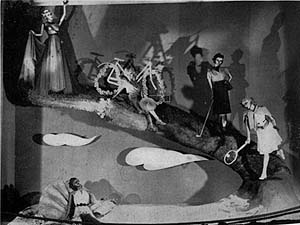At the very end of the Roaring Twenties, the stock market crashed and the country plummeted into a decade-long economic crisis. Mired in the throes of The Great Depression, people escaped to the movies.
Outside were bread lines and bankruptcies. Inside the darkened movie houses were wealth and glamour. Hollywood had a tremendous influence on fashion. Young men and women aspired to the looks and style of Astaire or Gable, Garbo or Harlow. In sharp contrast to the harsh realities of the Depression, the 1930s was the most elegant period in Hollywood's history. And retail took its cues from the movies.
In 1935, Cora Scovil, a renowned mannequin sculptor and window-dresser, captured the attitude of Hollywood's elite in a series of mannequins bearing the likenesses of Joan Crawford, Greta Garbo and Joan Bennett. And Lester Gaba produced a series of papier mâché mannequins modeled after Garbo, Marlene Dietrich and Carole Lombard. (Gaba was a premiere mannequin sculptor who brought his much-loved “Cynthia” with him everywhere he went. Cynthia hadn't a heart; she weighed in at 125 Plaster of Paris pounds.) Through the influence of Scovil and Gaba, mannequins assumed a new posture in American retail.
In a struggle for survival, new display techniques were introduced during the Depression years, cost-cutting practices that had an indelible effect on an evolving art form. Cellophane, cardboard and papier mâché replaced fine wood, stone and metal. Despite meager budgets, display artists'ingenuity produced a wealth of work later referred to as “the golden age of display.” At Saks Fifth Avenue, the legendary Henry Callahan said, “You've got to make magic, and you've got to create it with nothing.”
Retail in the 1930s was the showplace for new ideas, new concepts and new products. The store environment became the selling stage and theater for the offerings of the day. Following the examples of Woodward & Lathrop and Marshall Field's, merchants began to accessorize goods and to group kindred merchandise together, to facilitate ease of shopping and encourage multiple sales. As a precursor to this practice, Field's Clara Wilson positioned the first “spotlighted” color-accessorized mannequins throughout the store's fashion departments. She later remarked, “Spotlighting made it possible to create a dramatic ensemble of goods.” As the decade progressed, the drama and theater associated with elaborate show windows were imitated on the selling floors.
Advertisement
Lighting became the icing on the cake, adding magic to the static theater of display. Under the guidance of display director Irving Eldredge, Macy's rewired its show windows, installed adjustable spotlights and initiated the use of multi-colored filters. For the first time, display windows not only highlighted specific merchandise but also promoted and enhanced the store's image. Environmental branding was born.
Fashion visionaries inspired and motivated the retail world. One fashion merchandiser said, “There is not a commodity today that escapes fashion – there is fashion in furniture, cars, washing machines and tires.” Design elements such as color, line and form assumed an integral role in the manufacture of consumer goods. A new contour characterized industrial design, defined by the word “streamline.” This compelling aerodynamic profile influenced the design of everything from locomotives to lipstick. On the all-important railroads of the day, the new diesel electric locomotive was called, simply, a streamliner. Streamline sensibilities were married to the nuances of art deco, inscribing a distinctive line upon store interiors and across the face of the ever-evolving mannequin.
As the decade progressed, the lords of merchandising introduced shoppers to high art, co-joining two unlikely entities – fine art and mass culture. Museums and great retail emporiums began selling dreams in the guise of culture. And as merchants appealed to the consumer's lust for status, display artists turned to the influence of fine art.
In 1939, that conspiracy went over the top. Bonwit Teller engaged Salvador Dali to produce what was to become the most famous window in the annals of American display. Dali's “Narcissus White” window featured a claw-foot bathtub covered in white fur. A multitude of mannequin hands broke through the murky water, each holding a mirror up to the face of a mannequin wearing only a feathered negligee. The surreal window offended and horrified customers and store executives alike. When the window was altered without his consent, Dali reportedly pushed the fur-trimmed tub through the windowpane. He said of the experience, “It did more for my glory than if I'd eaten up all of Fifth Avenue.”
Photos courtesy of ST Publications, Cincinnati.


 Photo Gallery3 days ago
Photo Gallery3 days ago
 Headlines2 weeks ago
Headlines2 weeks ago
 Sector Spotlight2 weeks ago
Sector Spotlight2 weeks ago
 Headlines1 week ago
Headlines1 week ago
 Headlines5 days ago
Headlines5 days ago
 Headlines2 weeks ago
Headlines2 weeks ago
 Designer Dozen1 week ago
Designer Dozen1 week ago
 Headlines3 days ago
Headlines3 days ago















